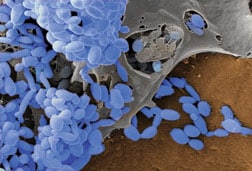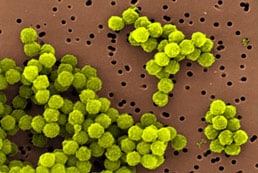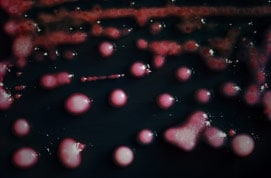Potential of Advanced Molecular Detection and Response at CDC
Frequently Asked Questions
- What is Advanced Molecular Detection (AMD)?
- Doesn’t CDC already do DNA sequencing? How is this different?
- So, how do these technologies increase the advantage over killer microbes?
- What about culture and polymerase chain reaction (PCR) based lab diagnostics? Are they obsolete?
- What is CDC hoping to accomplish with AMD?
- What is bioinformatics? How is it part of CDC’s AMD?
- Why AMD and why now?
- What does AMD look like when you put it to work against disease threats?
- What is the biggest health threat CDC sees AMD helping to combat?
- What are the tools of AMD?
- What has CDC done to determine its AMD needs?
- Has PulseNet accomplished what was intended when it launched over a decade ago?
- What about global disease threats?

What is Advanced Molecular Detection (AMD)?
AMD combines two powerful technologies (DNA or molecular sequencing and advanced computing) to solve complex infectious disease mysteries—the who, what, where, when, and how killer microbes harm people.
The basic tools of shoe leather epidemiology and laboratory benchwork that CDC's disease detectives relied on to answer outbreak questions on smallpox, Legionnaires' disease, E. coli and SARS can't be replaced; but, newer tools can make disease detectives more precise and faster in solving health mysteries.
New molecular tools and bioinformatics exist today and without these tools and technologies in place, CDC risks delays in confronting deadly health threats.
Doesn't CDC already do DNA sequencing? How is this different?
CDC's current molecular sequencing and bioinformatics capacities do not meet the challenges of this rapidly evolving field. CDC's use of the latest in genetic sequencing and bioinformatics could revolutionize how it and others investigate and controls infectious disease outbreaks.
CDC has used molecular detection tools such as polymerase chain reaction (PCR) and pulse-field gel electrophoresis (PFGE) for decades to improve disease detection and control. These tools examine pieces of DNA from microbes. Today's molecular tools look at the complete genetic makeup of pathogens—unlocking the key to understanding many unknowns in infectious disease control.
Consistently using molecular typing with bioinformatics, or AMD, will make CDC faster and more accurate.
So, how do these technologies increase the advantage over killer microbes?
Full or whole genomic sequencing rapidly generates massive amounts of information on an infectious agent and when analyzed by bioinformatics experts, CDC can put the puzzle together quicker, more precisely and, in the future, at decreased cost. What now takes a room full of equipment and a team of scientists weeks to accomplish, could be done in days or hours.
With enhanced molecular-based science and bioinformatics CDC could more rapidly and accurately diagnose infectious diseases, more quickly control outbreaks, predict patterns of disease transmission in real-time, more effectively tackle antimicrobial resistance, and better target interventions, like vaccines.
What about culture and polymerase chain reaction (PCR) based lab diagnostics? Are they obsolete?
While these tools will remain highly valuable, the use of next generation sequencing tools (in both clinical diagnostic use and microbiology research) is becoming more routine, offering quicker, less labor-intensive and less expensive means of diagnosing infections. Increasingly, diagnostic tests that do not use cultures are being developed and marketed for clinical use.
CDC needs to establish leading capability in the next generation of rapid, semi-automated, point-of-care molecular tests to meet national health security needs. CDC needs adequate AMD capacity in these areas to continue to provide leading expertise in adapting and deploying new technologies for public health efforts.
Top of PageWhat is CDC hoping to accomplish with AMD?
Save lives and protect our national health security. First rate scientists need first rate tools. CDC has attracted some of the brightest minds in science today. We count on them when deadly diseases suddenly emerge or when a resistant microbe sweeps across a hospital or when a suspect product makes its way into our food supply. They need the right tools at the right time to protect Americans from microbes that are growing more fierce and moving faster than ever among us.
What is bioinformatics? How is it part of CDC's AMD?
Bioinformatics is a 21st century science that combines biology, computers and information technology in a single discipline to answer pressing public health and medical questions. At CDC, bioinformatics experts are joining forces with infectious disease laboratory and epidemiology experts to go from "a hunch" to "certainty" in record time to prevent illness and save lives.
Why AMD and why now?
 Our national health security remains vulnerable with threats that push the limits of acceptable risk. These include emerging microbes, resistant microbes outsmarting the drugs to treat them, global risks in travel and trade, and the ease of creating deadly microbes in more and more labs. With new technologies adapted for public health response, CDC can help take many important disease threats off the table, if we act now.
Our national health security remains vulnerable with threats that push the limits of acceptable risk. These include emerging microbes, resistant microbes outsmarting the drugs to treat them, global risks in travel and trade, and the ease of creating deadly microbes in more and more labs. With new technologies adapted for public health response, CDC can help take many important disease threats off the table, if we act now.
Advances in genomics and advanced computing are revolutionizing the approach to detecting and controlling infectious disease threats. It is now possible to generate massive amounts of data within a very short time. However, to crack the case in real time requires high-performance computation to interpret what has been collected.
Top of PageWhat does AMD look like when you put it to work against disease threats?
In the United Kingdom, researchers used whole-genome sequencing to re-examine an outbreak of deadly MRSA in a neonatal unit. They were able to find a pattern in the outbreak, but also importantly identify MRSA cases unrelated to the outbreak. This is important because sometimes during an outbreak investigation more than one killer microbe or a similar microbe coming from more than one source can be present but unknown.
When similar disease threats are occurring in the same population, it can throw off the disease detectives and slow solving the problem. AMD helps put the puzzle together more precisely because the investigators can better detect different strains of the microbes and different sources—the pieces fit together more neatly and much more quickly.
Imagine putting together a 10 million-piece jigsaw puzzle with the speed you could normally do a 100-piece puzzle—that's AMD at work. Now imagine, while people are dying, trying to put a 10 million piece puzzle together when key pieces are missing and you have no picture to go by. That's what some CDC scientists struggle against today.
What is the biggest health threat CDC sees AMD helping to combat?
Highly resistant pathogens in health-care settings, killer microbes that jump from animals to humans, and emerging deadly pathogens emerging all create constant concern.
The World Health Organization and the CDC agree that drug-resistant microbes present a clear and present danger: to human lives and national economies. In the United States, the number of crippling outbreaks involving drug-resistant microbes is on the rise. Today, 5 killer microbes (and counting) are or nearly resistant to all antimicrobial drug treatments. These microscopic killers are preying on the weakest among us to grow stronger and spread wider, especially in hospitals. One in 20 hospitalized patients in the United States is infected during their health care.
In addition, CDC estimates that 1 in 6 Americans—or 48 million people—get sick from contaminated food each year—costing the United States $77 billion per year in health care treatment, workplace, and other economic losses.
However, these are the threats we see coming at us. Just as disturbing is the new pathogen that may jump from animals to humans and spark a firestorm of disease. Microbes jump from animals to humans and kill millions each year.
With AMD technologies adapted to public health use, CDC could rapidly look for a microbe's match among the thousands of reference samples in its world-class microbe library. If we did not find a match, CDC could take the whole genomic sequence of the microbe's DNA code, combine it with good disease detective work and apply bioinformatics to analyze it quickly and answer critical disease-response questions.
Top of PageWhat are the tools of AMD?
The most important tools, of course, are the experts in the fields of epidemiology, laboratory science and bioinformatics. These experts need two important classes of tools: sequencing machines that can read the DNA or RNA code of a microbe and supercomputers that have the capacity to manage massive amounts of information with the software to intelligently detect patterns. AMD tools make scientists faster and more accurate when lives are at risk.
What has CDC done to determine its AMD needs?
 In 2011, CDC convened a panel of external experts in the fields of bioinformatics and laboratory information technology. They assessed CDC's mission against its current capabilities. The panel found that CDC runs the risk of not being able to meet its basic mission unless it keeps pace with ongoing advances in technology to diagnose and characterize infectious agents. Whole genomic sequencing capability must be combined with advanced computing power and bioinformatics experts to translate the data. From their analyses, information can then be used to find disease patterns and interrupt disease transmission, create rapid diagnostic field tests, detect new pathogens, and characterize drug-resistant microbes. Importantly, AMD shaves off time consumed by conventional methods when trying to discover a way to protect people and communities.
In 2011, CDC convened a panel of external experts in the fields of bioinformatics and laboratory information technology. They assessed CDC's mission against its current capabilities. The panel found that CDC runs the risk of not being able to meet its basic mission unless it keeps pace with ongoing advances in technology to diagnose and characterize infectious agents. Whole genomic sequencing capability must be combined with advanced computing power and bioinformatics experts to translate the data. From their analyses, information can then be used to find disease patterns and interrupt disease transmission, create rapid diagnostic field tests, detect new pathogens, and characterize drug-resistant microbes. Importantly, AMD shaves off time consumed by conventional methods when trying to discover a way to protect people and communities.
Some of CDC's outbreak detection systems are predicted to be obsolete in just a few years if they do not keep pace with what are becoming routine technologies.
Has PulseNet accomplished what was intended when it launched over a decade ago?
CDC's PulseNet, a long-standing national network of public health and food regulatory agency laboratories, which uses DNA "fingerprinting" of bacteria that cause foodborne illnesses has made tremendous contributions to public health. PulseNet allows CDC and other public health laboratories to quickly identify outbreaks and track them to their source. This information gives the food industry and regulators information about what makes people sick so they can take the actions needed to make our food supply safe.
- PulseNet triggered outbreak investigations have resulted in the recall of well over one half billion pounds of contaminated food.
- PulseNet readily detected the large outbreak of Salmonella infections in 2009 that was linked to peanut butter. Because cases were spread across so many states, the outbreak may have gone undetected.
- During the 2011 multistate outbreak of Listeriosis linked to whole cantaloupes from Colorado, PulseNet public health laboratories rapidly identified the outbreak strains in Colorado patients.
What about global disease threats?
Good epidemiology is not merely determining what has happened, effective epidemiology must also anticipate and adapt within increasingly complex social structures. People and things are interconnected in almost limitless ways. AMD will give CDC the ability to derive actionable information from "big data" to protect people and save lives.
Since 1900, innovations in public health science have lengthened the average lifespan by 25 years.
Top of PageError processing SSI file
- Page last reviewed: April 15, 2014
- Page last updated: April 15, 2014
- Content source:
Error processing SSI file
Error processing SSI file


 ShareCompartir
ShareCompartir